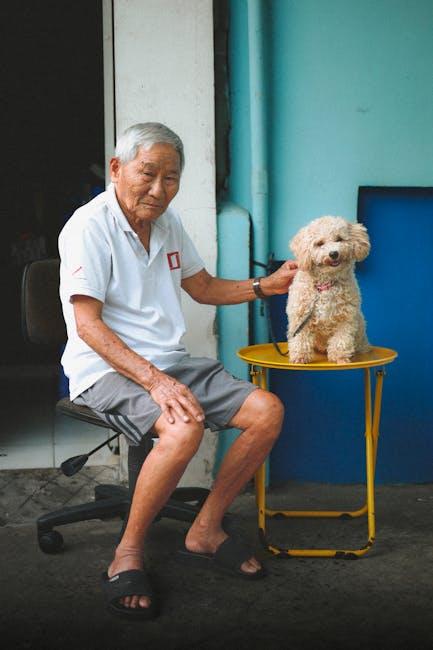Grooming a senior dog with special needs is more than just a routine task—it’s an opportunity to bond, show care, and ensure their comfort and well-being. As our furry companions age, they may face a variety of challenges, from mobility issues to sensitive skin, requiring a gentle and attentive approach. This guide will walk you through the essential steps of grooming your senior dog, offering tips tailored to their unique needs. Whether you’re a seasoned pet owner or new to caring for an older dog, this article aims to equip you with the knowledge and confidence to make grooming a positive and nurturing experience for both you and your beloved pet.
Understanding Your Senior Dogs Unique Grooming Needs
As our beloved furry companions age, their grooming needs can change significantly. Senior dogs may experience issues such as thinning fur, skin sensitivity, or arthritis, which can make the grooming process more challenging. It’s crucial to approach grooming with a gentle touch and a keen awareness of their comfort. Here are some tips to help you cater to your senior dog’s unique grooming needs:
- Choose the Right Tools: Opt for soft-bristled brushes and grooming gloves to reduce discomfort. A rubber brush can be particularly gentle on sensitive skin.
- Be Mindful of Temperature: Older dogs may have difficulty regulating their body temperature. Ensure the water is lukewarm and dry them thoroughly but gently to prevent chills.
- Pay Attention to Paws: Senior dogs might have weaker joints, so be cautious when handling their paws. Regular nail trimming is essential, but take care not to overextend their limbs.
- Check for Skin Issues: Aging can lead to various skin conditions. During grooming, inspect their skin for any signs of irritation, dryness, or unusual lumps, and consult your vet if needed.
By adapting your grooming routine to suit the specific needs of your senior dog, you not only help maintain their health but also provide a comforting bonding experience. Remember, patience and love are the best tools in your grooming kit.
Creating a Calm and Comfortable Grooming Environment
Ensuring your senior dog feels at ease during grooming starts with setting up a serene and inviting space. Consider the ambiance of the room—soft lighting and calming music can work wonders in reducing anxiety. A non-slip mat provides stability, helping your dog feel secure. It’s essential to keep the environment quiet and free from distractions to minimize stress. The temperature should be comfortably warm, preventing any chills during baths or grooming sessions.
- Comfortable surfaces: Use plush towels or blankets to cushion the grooming area.
- Aromatherapy: Lightly diffuse calming scents like lavender to create a soothing atmosphere.
- Gentle tools: Opt for soft-bristle brushes and quiet clippers designed for sensitive skin.
- Breaks: Allow your dog to rest periodically to prevent exhaustion.
Remember, patience is key. Your dog’s comfort should always be the priority, and taking the time to make the grooming environment as tranquil as possible will help ensure a positive experience for both you and your furry friend.
Gentle Techniques for Bathing and Brushing
When it comes to keeping your senior dog clean and comfortable, adopting gentle methods can make all the difference. Begin with a calming environment; ensure the bathing area is warm and quiet to avoid unnecessary stress. Use a soft, non-slip mat in the tub to prevent slipping and provide comfort for arthritic joints. Opt for a mild, hypoallergenic shampoo specifically formulated for sensitive skin. During the bath, speak softly and use a soothing touch, paying extra attention to areas that might be sore or sensitive. Rinse thoroughly to avoid any residue that could cause irritation.
For brushing, choose a brush with soft bristles or a grooming mitt to minimize pulling on fragile skin. Gently work through tangles and mats, being mindful of areas like the back, hips, and joints where your dog may be more sensitive. Regular brushing not only helps keep the coat healthy but also allows you to check for any unusual lumps, bumps, or signs of discomfort. Incorporating these gentle grooming practices into your routine will not only keep your senior dog looking their best but also strengthen the bond you share.
Addressing Mobility Challenges with Compassion
Caring for a senior dog with special needs requires a blend of patience, empathy, and knowledge. When grooming, always ensure their comfort is prioritized. Start by creating a calm environment, perhaps by playing soft music or using aromatherapy to soothe anxiety. Keep grooming sessions short and give plenty of breaks, allowing your dog to rest. If your senior dog has mobility issues, consider grooming them on a non-slip surface at a comfortable height to prevent strain on their joints.
- Use gentle, hypoallergenic products to protect their sensitive skin.
- Invest in a soft-bristle brush to avoid pulling on delicate fur.
- Be vigilant for any signs of discomfort, such as whining or shifting.
- Provide positive reinforcement with treats and soothing words.
Regular grooming is essential not only for maintaining your dog’s hygiene but also for checking for any changes in their health. Look for lumps, skin irritation, or any signs of pain. Remember, each grooming session is an opportunity to bond with your pet and show them the love and care they deserve in their golden years.

